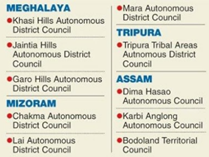TAG: GS-2: POLITY & GOVERNANCE
THE CONTEXT: Ladakh activist Sonam Wangchuk ended his indefinite fast on 21 October 2024 after receiving a letter from the Union Home Ministry on future negotiations about the administration of the union territory.
EXPLANATION:
More about news:
- In the last couple of years, Ladakh has been the location of many developmental projects. These include India’s first geothermal power plant and green hydrogen unit. Seven hydropower projects are also proposed to be built on the Indus River and its tributaries. These rapid development projects challenge the fragile ecosystem of Ladakh.
- Recently, climate activist, Sonam Wangchuk, was detained at the Delhi border while leading a protest for Ladakh’s inclusion in the Sixth Schedule of the Constitution. The demand for sixth schedule status is aimed for greater autonomy to the region. While the demands for a separate public service commission and two parliamentary seats were met, the demands of the statehood for Ladakh and its inclusion under the sixth schedule of the Indian constitution has been rejected by the MHA.
- Also, recently, similar demands have been made in Arunachal Pradesh and Manipur for their inclusion in the sixth schedule. The focus is on the protection of ethnic groups under special constitutional provisions.
- Ladakh has a tribal population of more than 97 percent, fulfilling the criteria for Sixth Schedule status.
What is the 6th Schedule of the Indian Constitution:
- The Sixth Schedule of the Constitution provides for the administration of tribal areas in Assam, Meghalaya, Tripura and Mizoram to safeguard the rights of the tribal population in these states. This special provision is provided under Article 244(2) and Article 275(1) of the Constitution.


- Passed by the Constituent Assembly in 1949, the Sixth Schedule was formulated to provide the limited autonomy to the tribal regions of North-East.
- It was based on the reports of Bardoloi Committee formed by the Constituent Assembly.
- The committee report stated that there was a need for a system of administration that would allow tribal areas to become developed.
- The report also called for the protection of these tribal areas from exploitation by the people in the plains and preserving their distinct social customs.
- It gives the tribals freedom to exercise legislative and executive powers through an autonomous regional council and autonomous district councils (ADCs)
- The ADCs are the districts within the state to which the central government has given varying degree of autonomy within the State Legislature.
- To autonomous districts and autonomous regions, the acts of Parliament or the state legislature do not apply or apply with specified modifications and exceptions.
- The Governor can appoint a commission to investigate and provide a report on any issue pertaining to the management of the autonomous districts or regions.
Significant provisions of the Sixth Schedule:
Autonomous districts and autonomous regions:
- The tribal areas in the four states of Assam, Meghalaya, Tripura, and Mizoram are to be administered as Autonomous Districts.
- If there are different Scheduled Tribes in an autonomous district, the Governor can divide the district inhabited by them into Autonomous Regions.
- The Governor is empowered to organize and reorganize the autonomous districts. He can also increase, decrease the boundaries or alter the name of any autonomous district.
Constitution of District Councils and Regional Councils:
- There shall be a District Council for each autonomous district consisting of not more than 30 members, of whom not more than four persons shall be nominated by the Governor, and the rest shall be elected on the basis of adult suffrage.
- There shall be a separate Regional Council for each area constituted an autonomous region.
Powers of the District Councils and Regional Councils to make laws:
- The District and Regional councils are empowered to make laws on certain specified matters like lands, management of forest (other than the Reserved Forest), inheritance of property, etc.
- These councils also empowered to make law for the regulations and control of moneylending or trading by any person other than Scheduled Tribe residents in that Scheduled District.
- However, all laws made under this provision require the assent of the Governor of the State.
Administration of justice in autonomous districts and autonomous regions:
- The District and Regional Councils are empowered to constitute Village and District Council Courts for the trial of suits and cases where all parties to the dispute belong to Scheduled Tribes within the district.
- The High Courts have jurisdiction over the suits and cases which is specified by the Governor.
- However, the Council Courts are not given the power to decide cases involving offenses punishable by death or imprisonment for five or more years.
The District and Regional Councils are empowered to assess and collect land revenue and impose taxes on professions, trades, animals, vehicles, etc. The Councils are given the power to grant licenses or leases for the extraction of minerals within their jurisdiction.
- The District Councils and Regional Councils are given the power to establish, construct or manage primary schools, dispensaries, markets, cattle ponds, fisheries, roads, road transport and waterways in the districts.
Source:
https://indianexpress.com/article/explained/ladakh-sonam-wangchuk-fast-schedule-6-9633470/
Spread the Word
